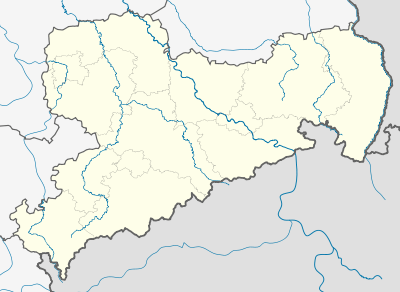Rackwitz
Rackwitz is a municipality in the district of Nordsachsen, in Saxony, Germany.
Rackwitz | |
|---|---|
 Coat of arms | |
Location of Rackwitz within Nordsachsen district  | |
 Rackwitz  Rackwitz | |
| Coordinates: 51°26′N 12°23′E | |
| Country | Germany |
| State | Saxony |
| District | Nordsachsen |
| Subdivisions | 7 |
| Government | |
| • Mayor | Manfred Freigang |
| Area | |
| • Total | 39.92 km2 (15.41 sq mi) |
| Elevation | 129 m (423 ft) |
| Population (2018-12-31)[1] | |
| • Total | 5,030 |
| • Density | 130/km2 (330/sq mi) |
| Time zone | CET/CEST (UTC+1/+2) |
| Postal codes | 04519 |
| Dialling codes | 034294, 034202 |
| Vehicle registration | TDO, DZ, EB, OZ, TG, TO |
Geography
Site, situation and location
Rackwitz is about 10 km north of Leipzig and 13 km south of Delitzsch.
The surrounding landscape belongs to the Leipzig Bay and is drained by the river Lober, a tributary of the Mulde. The lakes Schladitzer See and Werbeliner See, which were created from disused open-cast mines, are situated nearby.
Leipzig Trade Fair Center and Leipzig/Halle Airport are also in the vicinity.
Villages
Rackwitz municipality contains the following villages with populations in brackets:
|
|
Also within the municipality's area are the footprints of the now demolished villages Schladitz with Kömmlitz, Kattersnaundorf and Werbelin, on the sites of which are now lakes, formerly open-cast lignite mines.
History
The Rackwitz area was settled by Slavs in prehistoric times. The name Rak means shrimp, and can be seen in the coat of arms. Der Ort Rackwitz ist aus den Orten Rackwitz und Güntheritz entstanden. The oldest part of the present day municipality is Podelwitz, which was documented in 1250. Since 1349/50 Zschortau and Rackwitz were mentioned in documents. Brodenaundorf was mentioned in 1547.
At the start of the 15th Century, plague and famine decimated Rackwitz. The municipality was also plundered during the Thirty Years War. In 1692 trials for witchcraft took place in Rackwitz in which two witches were tried.[2]
On June 21, 1871 a train crash killed 19 and injured 56 in the vicinity of Rackwitz.[3]
Mergers and Annexations
| Former municipality | Date | Comment |
|---|---|---|
| Biesen | 1. July 1950 | Merged into Zschortau |
| Brodenaundorf | 1. July 1950 | Merged into Zschortau |
| Güntheritz | between 1925 und 1939 | Annexed by Rackwitz |
| Kattersnaundorf | 1981 | Demolished in 1981 to make way for the open-cast lignite mine Delitzsch-Southwest devastiert, and thereby merged into Zschortau |
| Kömmlitz | 1 April 1936 | Merged into Schladitz, then demolished in 1986-89 for lignite mine |
| Kreuma | 1 May 1974 | Merged into Zschortau |
| Lemsel | 1 March 1994 | Merged into Zschortau |
| Podelwitz | 1999 | Merged into Rackwitz |
| Schladitz | 1989 | demolished in 1986-89 for lignite mine and thereby annexed by Rackwitz. Gives its name to the lake on the site of the lignite mine, known as Schladitzer Bucht. |
| Werbelin | 1 January 1957 | Merged with Kattersnaundorf, when Kattersnaudorf was demolished in 1981, Werbelin was merged into Zschortau, and was itself demolished in 1992 for the mine. |
| Zschortau | 1 March 2004 | Annexed by Rackwitz |
Historical Population
Note that the population figures in the table below include the figures for other districts that were merged with Rackwitz at various points in time (see table above, thereby accounting for significant increases.
| Historical Population of Rackwitz | |||||||||||||
|---|---|---|---|---|---|---|---|---|---|---|---|---|---|
| Year | 1818 | 1880 | 1895 | 1910 | 1925 | 1939 | 1946 | 1950 | 1964 | 1990 | 2000 | 2013 | 2015 [4] |
| Inhabitants | 76 | 96 | 113 | 124 | 192 | 1055 | 1375 | 1329 | 1786 | 3228 | 3388 | 4916 | 4855 |
Culture and Sights



Buildings
- The church in Podelwitz was gifted from Henry the Illustrious of the House of Wettin to the Teutonic Order on Christmas Eve 1250.
- The church in Zschortau contains the last remaining organ by Johann Scheibel, which was tested by Johann Sebastian Bach.[5]
- Only the tower remains from the church in Kreuma.
- Castle in Zschortauer Park which is today an educational institution.
- Herrenhaus of the Rittergutes Güntheritz
References
- "Bevölkerung des Freistaates Sachsen jeweils am Monatsende ausgewählter Berichtsmonate nach Gemeinden" (PDF). Statistisches Landesamt des Freistaates Sachsen (in German). July 2019.
- Manfred Wilde: Die Zauberei- und Hexenprozesse in Kursachsen, Cologne, Weimar, Vienna 2003, page 509.
- Martin Weltner: Bahn-Katastrophen. Folgenschwere Zugunfälle und ihre Ursachen. Munich 2008. ISBN 978-3-7654-7096-7, page 14.
- "Archived copy". Archived from the original on 2015-12-22. Retrieved 2015-12-16.CS1 maint: archived copy as title (link)
- http://www.leipzigerneuseenland.de/en/node/2619